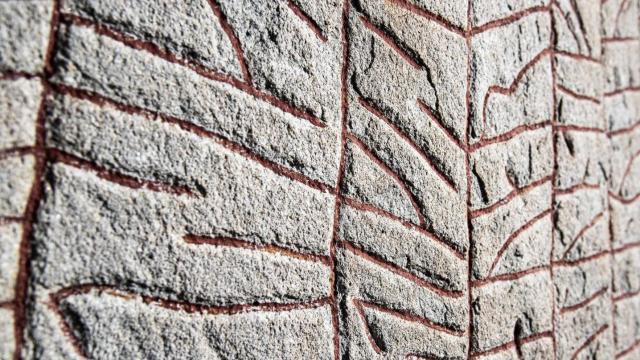An updated interpretation of the famous Rök runestone suggests Vikings were preoccupied by the threat of a climate calamity.
The Rök runestone was completed and upraised in what is now Östergötland, Sweden, around 800 CE, and it was long thought to describe a series of battles. Given that the poem inscribed on the rune was written as a series of riddles, this interpretation has remained just that—an interpretation.
New research published in Futhark: International Journal of Runic Studies offers a radical new take on this old poem. Yes, the poem most certainly describes a conflict—but it’s a conflict in which Vikings are pitted against the natural, if not the metaphysical, world. The new paper was a collaboration between researchers from the University of Gothenburg, Stockholm University, and Uppsala University.
An interdisciplinary effort was required to reassess the meaning of the Rök runestone, and it involved experts from archaeology, history, religion, runology, and textual analysis. Without such an approach, “it would have been impossible to solve the riddles of the Rök runestone,” said Per Holmberg, the lead author of the study, in a press release.
Of the nine riddles presented in the runes, the answers to five had to do with the Sun—the bringer of light and warmth. The remaining four answers were concerned with Odin and his warriors. Here is one example, the answer to which the authors say is “the Sun.”
Second, let’s say this, who, nine generations ago, lost life to the East but still rules? The bold warrior, the men’s chief, rode on the horse across the horizon to the east. Now sits, the foremost of the famous, equipped on his horse with the shield prepared.
This riddle basically asks, “who was dead but lives again,” the answer to which is the Sun, argue the researchers, who say the “lost life” refers to a solar eclipse that happened near sunrise. Holmberg and his colleagues referenced Old Norse texts to help them solve the riddles, which they say contained previously missed parallels to the Rök runestone.
The new paper argues that the Vikings responsible for the Rök runestone weren’t referencing prior battles but a previous climate catastrophe that happened generations earlier, around 536 CE, resulting in lower temperatures, crop failures, and starvation.
“Before the Rök runestone was erected, a number of events occurred which must have seemed extremely ominous: a powerful solar storm coloured the sky in dramatic shades of red, crop yields suffered from an extremely cold summer, and later a solar eclipse occurred just after sunrise,” said study co-author Bo Gräslund in a statement. “Even one of these events would have been enough to raise fears of another Fimbulwinter.”
By Fimbulwinter, Gräslund is referring to the Viking belief that a long, extreme winter would proceed Ragnarok, the ultimate destruction of the cosmos (yeah, the Vikings were dramatic). The recent climate calamity still seared in the Vikings’ collective memory, the runes were a callback to this dark era and a warning of environmental and spiritual threats yet to come.
Things had largely gone back to normal when the Rök runestone was built, but the climate catastrophe resulted in sweeping changes to Viking society, as the authors explained in the study:
In the restructuring of farming after the climate crisis, social stratification had increased, and power seems to have been concentrated in the hands of a new type of leadership, legitimized by ritual assurance of good harvests, as well as military control of land. Claiming a special relation to Odin, the new ruling elite constructed themselves as necessary defenders against both real-life enemies, and destructive cosmic powers, since Odin was conceived of as a divine warlord engaged in the outcome of both human battles and the eschatological battle of Ragnarok, where he would lead divine and human warriors in a final encounter with the giants.
So the Rök runestone, according to the researchers, was a kind of reassurance from the new and powerful ruling elite to the people—that they had things under control, such as guaranteeing a good harvest or keeping together “the fragile balance between light and darkness,” as co-author Olof Sundqvist put it in the press release. Finally, at Ragnarok, “they would fight alongside Odin in the final battle for the light,” he said.
It’s a compelling interpretation, no doubt. It’ll be interesting to hear how other scholars react to this new study and whether it stands the test of time. If you want to take a stab at these riddles yourself, you can check them out here.
[referenced url=” thumb=” title=” excerpt=”]
This is hardly the first study to suggest that major environmental events influenced Viking society and poetry. Back in 2018, researchers argued that a horrific volcanic eruption lasting from 939 to 940 CE led the Vikings to abandon their Norse gods and turn to Christianity. The researchers who led this study came to their conclusion by nailing down the date of the eruption and by referencing a Viking poem called Vǫluspá.
